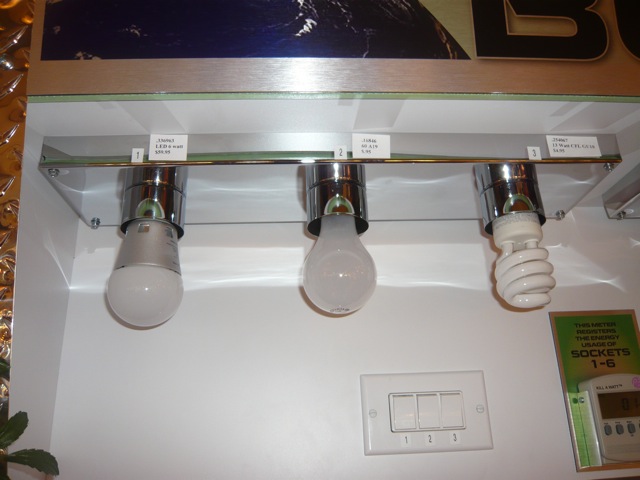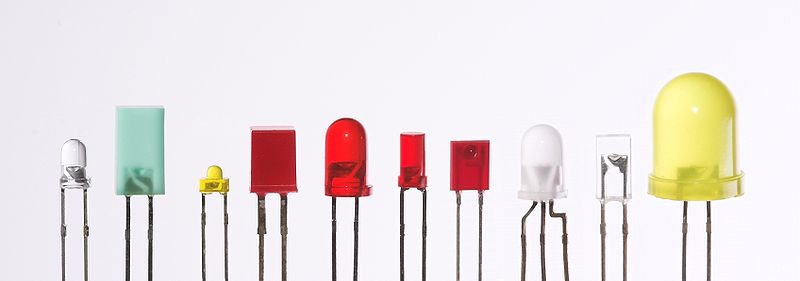Converting Your Home to LED Lighting: Is it Really Worth It?
By admin on Apr 8, 2010 in Analysis, Reviews
LED stands for Light Emitting Diode, and as you probably already know these high-efficiency lights can be found literally everywhere these days, from the old LED wristwatches (Pulsar anyone?) to modern stop lights to televisions to Christmas lights.
Where you don’t see them as often are as light fixtures in homes and businesses. That’s been slowly changing and we’ve been getting an increasing number of questions from people who are thinking about adding LEDs as lighting sources to their homes.
So we thought we’d learn a little more about this type of light and its use in homes and find out if it’s really worth it to convert your home to LED bulbs.
LED fixtures available for home use
Now that they’ve been on the market for awhile the diversity of LED fixtures continues to grow. We’ve found them in a variety of home applications, including:
- Bulbs and globes for use in lamps and fixtures
- LED Flood lights for outdoors
- Spotlights for indoors and outdoors
- Track lights for accent lighting
- Candle bulbs for chandeliers and candelabras
- Strip lights for under shelves and cabinets
You can also get many of these products in different colors now, ranging from stark white to soft yellows, greens, blues, and reds.
I really like the thought of using LEDs for hard-to-reach bulbs and outdoor lighting. No more hoisting yourself up a giant ladder just to reach a light under the eve that burned out because you forgot to turn it off the night before. Also, LEDs don’t emit ultraviolet light, so they don’t attract bugs.
LED fixtures do cost more – a lot more
There’s not doubt LED fixtures cost more than other types. We trekked over to the Globe Lighting store in Vancouver, WA to make some comparisons of common lighting fixtures. (Thanks for the help, Vicki.) Here’s what we found:
| Type | Cost | Wattage | Longevity in Hours |
| Light bulb (60W equivalent) | |||
| Incandescent | $.95 | 60W | 600-1k hours |
| Compact Fluorescent | $4.95 | 13W | 3k-5k hours |
| LED | $59.95 | 6W | 30k-50k hours |
| PAR Lamp (Parabolic Aluminized Reflector – For Recessed Lighting – 50W equivalent) | |||
| Incandescent: | $8.50 | 50W | 600-1k hours |
| Compact Fluorescent: | $12.95 | 15W | 3k-5k hours |
| LED | $79.95 | 11W | 30k-50k |
| Candles for Candelabras (25W equivalent) | |||
| Incandescent: | $1.30 | 25W | 600-1k hours |
| Compact Fluorescent: | $3.95 | 5W | 3k-5k hours |
| LED | $18.95 | 1.7W | 30k-50k hours |
| Averages | |||
| Incandescent: | $3.58 | 45W | 600-1k hours |
| Compact Fluorescent: | $7.28 | 11W | 3k-5k hours |
| LED | $52.95 | 6.2W | 30k-50k hours |
For light bulbs, where we found the greatest disparity in price, LEDs right now can be as much as 60X more expensive that incandescent, yet last nearly 50X longer (we’re using the greatest numbers). LEDs are 12X the price of compact fluorescents, and last 10X longer. Yet for PAR lamps and candelabra candles the price gaps shrink considerably, making them a better value based on price vs. longevity.
LEDs do save energy, a lot of it, and could be a good long-term “investment” for your home
(Warning: Math Content*)
There’s no doubt that LEDs use less energy than incandescent, halogen or even fluorescent bulbs while emitting about the same amount of light. In fact, LEDs can use a watt or less to up to 11 watts for the brightest ones. If we assume that your home has 100 light bulbs, including outdoors and those in candelabras, and the average cost of LEDs is $52 each, you would pay $5,200 to retrofit.
Now, if you refit ALL your applicable incandescent bulbs with LEDs you could presumably save up to 86% of your lighting costs (although this does not account for energy losses to the fixtures). Lighting typically accounts for only 15% of your total electrical bill, with heating and cooling using the greatest amount of energy. That means if you pay $100 per month in electricity, you would save $12.90 per month – (.15 x $100) x.86 = $12.90. So you’re paying $5,200 for an energy savings of $154.80 per year.
There’s even more savings. This does not include the replacement of your other bulbs, which would be burning out regularly, let’s say once a year (although this is just a guess to keep the math simple). So if at most the average replacement cost of incandescent bulbs is about $3.50 each your would save an additional $350 per year, for a total savings of $504 per year, or a 10% return on cost of the LEDs per year. After 10 years you would get roughly $5,004 back.
Let’s compare that to compact fluorescents. If you replaced all your incandescent bulbs with compact fluorescent bulbs you would pay about $728 – $7.28 x 100 = $728. Since we’re assuming you would change your incandescents once a year and compact fluorescents last 5X longer then we would double that to get the 10-year cost of $1,456. During that time you would save about (.15 x 100)x.75 = $11.25 per month, or $135 per year. After 10 years you would save roughly $3,414 in energy and replacement costs over incandescent bulbs.
| Type | Initial Cost | 1-year savings less replacement costs |
5-year savings less replacement costs |
10-year savings less replacement costs |
20-year savings less replacement costs |
| Incandescent** | $358 | -$358 | -$1,790 | -$3,580 | -$7,160 |
| Compact Fluorescent*** | $728 | $493 | $1,707 | $3,414 | $6,828 |
| LED | $5,200 | $504 | $2,520 | $5,040 | $10,080 |
**Incandescent bulbs would need to be changed every year, on average.
***Compact fluorescent bulbs would need to be changed every 5 years, on average.
Fluorescents seem like a better deal, except manufacturers claim LEDs can last 10X longer than even those thrifty bulbs, given them a potential lifespan of 50 years, based on our assumptions*. Does that mean you could get $25,000 back on your $5,200 investment versus a return of $24,250 on a cost of $7,280 over 50 years for compact fluorescents? I don’t know, but suffice it to say that you probably won’t be buying LEDs just because of the monthly savings. If you’re not all about dollars and value, then LEDs still make a lot of sense because of the energy savings.
(*We are making some key assumptions in this math, especially in regards to bulb longevity, and we will be happy to amend these numbers if someone has compelling evidence that they need to be changed.)
Should I buy LEDs for my home?
The answer to this depends on your goals. If you want to save energy at any cost, then LEDs are a great way to go green. If you are planning to stay in your home for 10 years, then there’s a good chance you will recoup the money you put into your LEDs. But if you are on a strict budget, then LEDs might just be too expensive for you to convert all your lights. You could try experimenting with outdoor and garage lights, which often can be difficult to change and expensive if they’re left on for long periods of time (ooops). Remember our example from above: If your home has 100 light bulbs, it would cost $5,200 to cast that house in the “green” glow of LEDs.
Pros
- Energy-efficient – An LED bulb that puts out the same amount of light as a 60 Watt incandescent only uses about 6 Watts.
- Long-lived – LEDs can last for 30,000-50,000 hours. Presumably that means you could leave an LED on continuously for nearly 6 years.
- Durable – LEDs are resistant to shock, extreme changes in temperature (although high heat can shorten their lives), and repeated cycling (turning off and on).
- Safe – LEDs bulbs operate at lower temperatures than other bulbs. You can’t even touch a halogen bulb when it’s off for fear of the oils on your fingers heating to a point that it shatters the bulb.
- UV free – LEDs don’t emit ultraviolet light, which can damage artwork and which attracts bugs
- Interference free – LEDs don’t have ballasts like fluorescents, so they don’t interfere with radio signals
- Multi-colored – LEDs can be manufactured in many different colors and don’t require filters – they literally make monochromatic light.
Cons to LEDs
- Expensive – No matter how you look at it this is the single most important deterrent to LEDs becoming more prevalent.
- Heat-sensitive – The lifespan of LEDs can be greatly reduced by excessive heat.
- Glare – LEDs can cast very bright glare off surfaces such as granite without a diffuser.
- Look – They’re getting much better that the blue-hued versions we are used to seeing, but can be a little overwhelming.
Links:
Where to get them:
Globe Lighting (My local favorite)
There’s also plenty of LED products available through online retailers. We’ve never purchased anything from these guys, but here’s a quick list:
Manufacturers:
History:
Facts and History of LEDs from Wikipedia














Right now, from a strictly “return on investment” point of view, LED lights are not that compelling for home use because most people don’t have their lights on for more than a few hours per day on average. For the normal homeowner it will take several years to pay back the original investment. That being said, most people don’t buy things for their home on the basis of “payback”, they buy them for their comfort, convenience, enjoyments, and environmental benefits regardless of “payback period”. We’ve been pleasantly surprised at how many people have been purchasing our Lumicrest LED lighting for their homes, perhaps because they don’t like the excessive heat put out by halogen and incandescent lamps, and don’t like the light quality and the mercury content of CFL lights… and the fact that those CFLs often don’t last as long as they are reputed to.
David | Jul 26, 2010 | Reply
Hi David – I absolutely agree that people right now who are buying LEDs often are not looking for ROI, but for the right look. They are a popular choice in high-end homes. Still, it was an interesting exercise to do the math. Thanks for the comment!
admin | Jul 27, 2010 | Reply